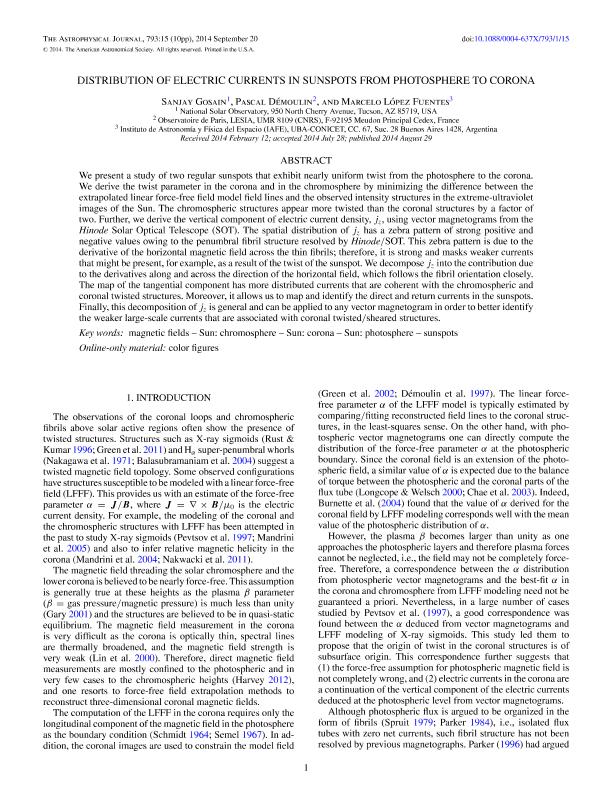Mostrar el registro sencillo del ítem
dc.contributor.author
Gosain, Sanjay
dc.contributor.author
Démoulin, Pascal

dc.contributor.author
Lopez Fuentes, Marcelo Claudio

dc.date.available
2017-06-02T19:18:03Z
dc.date.issued
2014-09-20
dc.identifier.citation
Gosain, Sanjay; Démoulin, Pascal; Lopez Fuentes, Marcelo Claudio; Distribution of electric currents in sunspots from photosphere to corona; Iop Publishing; Astrophysical Journal; 793; 1; 20-9-2014; 15,1-10
dc.identifier.issn
0004-637X
dc.identifier.uri
http://hdl.handle.net/11336/17400
dc.description.abstract
We present a study of two regular sunspots that exhibit nearly uniform twist from the photosphere to the corona. We derive the twist parameter in the corona and in the chromosphere by minimizing the difference between the extrapolated linear force-free field model field lines and the observed intensity structures in the extreme-ultraviolet images of the Sun. The chromospheric structures appear more twisted than the coronal structures by a factor of two. Further, we derive the vertical component of electric current density, jz , using vector magnetograms from the Hinode Solar Optical Telescope (SOT). The spatial distribution of jz has a zebra pattern of strong positive and negative values owing to the penumbral fibril structure resolved by Hinode/SOT. This zebra pattern is due to the derivative of the horizontal magnetic field across the thin fibrils; therefore, it is strong and masks weaker currents that might be present, for example, as a result of the twist of the sunspot. We decompose jz into the contribution due to the derivatives along and across the direction of the horizontal field, which follows the fibril orientation closely. The map of the tangential component has more distributed currents that are coherent with the chromospheric and coronal twisted structures. Moreover, it allows us to map and identify the direct and return currents in the sunspots. Finally, this decomposition of jz is general and can be applied to any vector magnetogram in order to better identify the weaker large-scale currents that are associated with coronal twisted/sheared structures.
dc.format
application/pdf
dc.language.iso
eng
dc.publisher
Iop Publishing

dc.rights
info:eu-repo/semantics/openAccess
dc.rights.uri
https://creativecommons.org/licenses/by-nc-sa/2.5/ar/
dc.subject
Magnetic Fields
dc.subject
Sun: Corona
dc.subject
Sun: Photosphere
dc.subject
Sunspots
dc.subject.classification
Astronomía

dc.subject.classification
Ciencias Físicas

dc.subject.classification
CIENCIAS NATURALES Y EXACTAS

dc.title
Distribution of electric currents in sunspots from photosphere to corona
dc.type
info:eu-repo/semantics/article
dc.type
info:ar-repo/semantics/artículo
dc.type
info:eu-repo/semantics/publishedVersion
dc.date.updated
2017-06-01T16:45:24Z
dc.journal.volume
793
dc.journal.number
1
dc.journal.pagination
15,1-10
dc.journal.pais
Reino Unido

dc.description.fil
Fil: Gosain, Sanjay. National Solar Observatory; Estados Unidos
dc.description.fil
Fil: Démoulin, Pascal. Centre National de la Recherche Scientifique. Observatoire de Paris; Francia
dc.description.fil
Fil: Lopez Fuentes, Marcelo Claudio. Consejo Nacional de Investigaciónes Científicas y Técnicas. Oficina de Coordinación Administrativa Ciudad Universitaria. Instituto de Astronomía y Física del Espacio. - Universidad de Buenos Aires. Facultad de Ciencias Exactas y Naturales. Instituto de Astronomía y Física del Espacio; Argentina
dc.journal.title
Astrophysical Journal

dc.relation.alternativeid
info:eu-repo/semantics/altIdentifier/doi/http://dx.doi.org/10.1088/0004-637X/793/1/15
dc.relation.alternativeid
info:eu-repo/semantics/altIdentifier/url/http://iopscience.iop.org/article/10.1088/0004-637X/793/1/15
Archivos asociados
